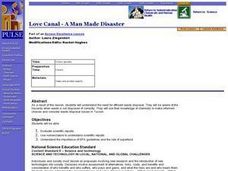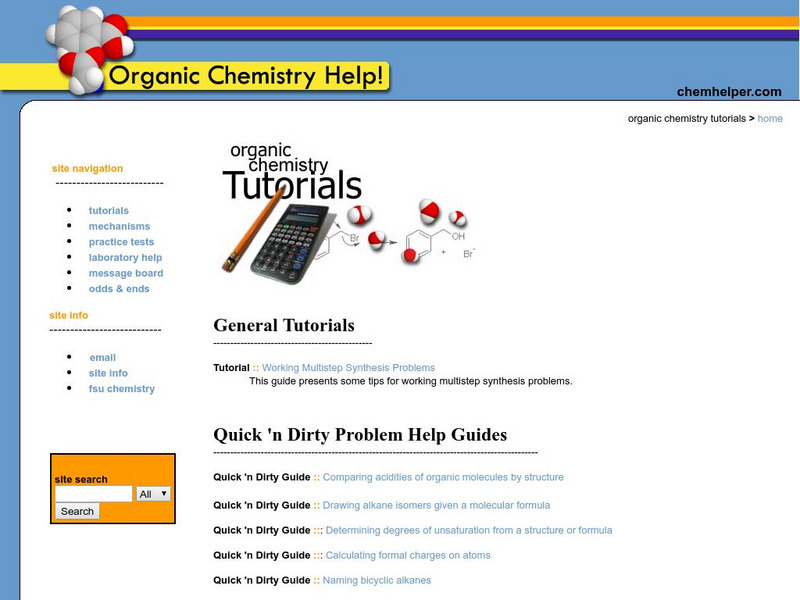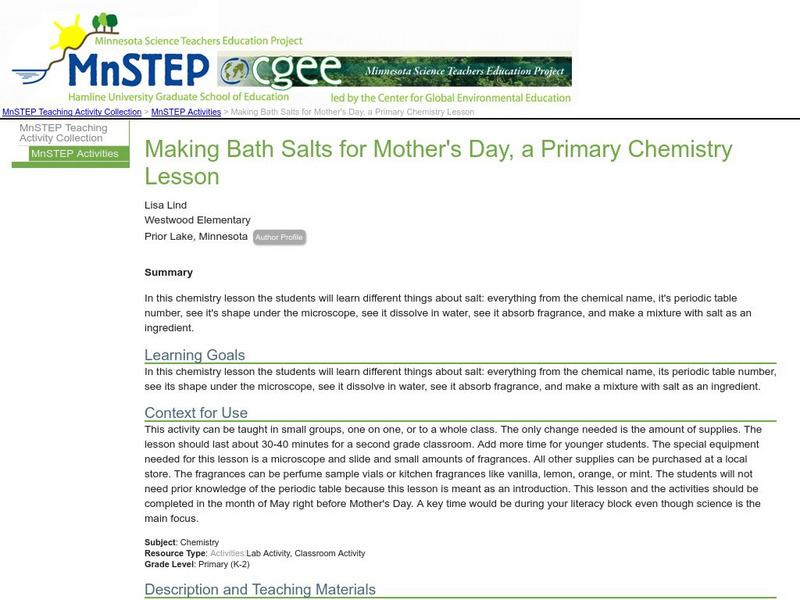Virginia Department of Education
Partial Pressure
At some point, everyone has been under pressure—even Dalton! Explore Dalton's law of partial pressures with young chemists as they measure the volume of air extracted from a sample compared to its original volume. Class...
Curated OER
Oxidation Numbers and Ionic Compounds
In this oxidation numbers and ionic compounds activity, students write the formula for compounds given ions, they write the ions given formulas, they list oxidation numbers for elements, they write formulas for compounds and they name...
Virginia Department of Education
Soap, Slime, and Creative Chromatography
Do you think chromatography paper suffers from separation anxiety? Young chemists make soap, slime, silly putty, and experiment with chromatography in this lesson. The material includes clear instructions for each experiment along with...
Curated OER
Binary Compounds
In this compounds worksheet, students write the oxidation numbers for the given elements and then write the formulas for the given binary compounds. This worksheet has 3 problems to solve.
Curated OER
Empirical and Molecular Formulas
In this compounds worksheet, students write the empirical formulas or the molecular formula for the given chemical compounds. This worksheet has 20 problems to solve.
Curated OER
Love Canal-A Man Made Disaster
Students watch a "Waste Management" Power Point as well as a "Love Canal" PowerPoint (a link is provided for the second presentation). Students write the chemical formula for each chemical and convert the contamination to grams using...
American Chemical Society
Development of Baking Powder
Did you know baking powder can be used to treat acne, whiten teeth, and make sugar cookies? The lesson on the development of baking powder is ready-to-go with no preparation required. Through readings, pupils answer questions, complete...
American Chemical Society
Joseph Priestley, Discoverer of Oxygen
Do you want to hear a joke about nitrogen and oxygen? NO. We all know there is oxygen in the air and that plants produce oxygen, but how was it discovered? Scholars read a handout, answer questions, and analyze material in the...
National Institute of Open Schooling
Biomolecules
An informative lesson has learners read about, discuss, and study the classification, structure and importance of the following biomolecules: carbohydrates, proteins, lipids, nucleic acids, and enzymes.
National Institute of Open Schooling
Periodic Table and Atomic Properties
An in-depth lesson, the fourth activity in a series of 36, begins with teaching how the periodic table's arrangement came to its current design. Using this knowledge, pupils then move on to analyze the arrangement of elements to their...
Curated OER
Pesticide Prevalence
Students investigate the prevalence of pesticides in their communities by
searching their homes, visiting local stores and talking to extended family and friends. They conduct their search by classifying pesticides based on the pests...
Curated OER
Learning how to balance equations
Students play Chembalancer game and balance equations using the trial and error method.
Curated OER
Determine the molarity of an unknown HCl solution
Students complete a lab to help develop a comprehension of stiochiometry. They review equation writing, equation balancing, and stiochiometry. Studnets are given the following information: Sloppy students from the previous class have...
Curated OER
Naming Acids
In this naming acids worksheet, students are given a chart with polyatomic ions and acid names with oxidation states, prefixes and suffixes. They use the chart to help name the eighteen given acids.
Curated OER
Unknown Element Project
Students work with a partner to determine the identity of an unknown element based on given descriptions. Groups use classroom textbooks, encyclopedias, and science internet sites to identify their unknown element then write a report as...
Curated OER
Little Me in a Big World: Ants
First graders predict, observe and record strategies to overcome them using discussions, role play, and charts. Over a three or four day period, they examine obstacles that humans and insects encounter.
California State University
Csudh Www Project for Chemistry: Nomenclature
This site from CSUDH WWW Project For Chemistrygives an interactive online nomenclature practice problems and drills. Click on star icon to start drill.
CK-12 Foundation
Ck 12: Chemistry for High School
This digital textbook covers core chemistry concepts and includes interactive features, real-world examples, and videos.
Other
School of Chemistry: Amines
An introduction to amine chemistry. Includes naming, examples and real world examples.
Other
Frostburg State University: Organic Chemistry Tutorials
This site features tutorials on alkenes, alkanes, alkynes, alcohols, carboxylic acids, amines, ketones, aldehydes, and benzene. The tutorials lists the properties of each, structure and classification, the nomenclature, and gives...
CK-12 Foundation
Ck 12: Chemistry: Stock System Naming
[Free Registration/Login may be required to access all resource tools.] Explains Stock system and nomenclature of transition metal compounds.
Chiral Publishing
Chiral Publishing: An Introduction to Chemistry: Ionic Nomenclature
Test yourself on ionic nomenclature. Convert either names to formulas or formulas to names. After this quiz, you'll remember how to name cations and anions.
Chiral Publishing
Chiral Publishing: An Introduction to Chemistry: Binary Covalent Nomenclature
Quiz yourself on binary covalent nomenclature with this interactive animation. Convert formulas to names or names to formulas while learning some common compounds.
Science Education Resource Center at Carleton College
Serc: Making Bath Salts for Mother's Day, a Primary Chemistry Lesson
What do you know about salt? In this chemistry lesson, learners will learn different things about salt: the chemical name, it's periodic table number, it's shape under the microscope, how it dissolves in water, and how to make a mixture...

























